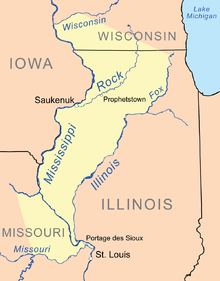Encyclopedia Dubuque
"Encyclopedia Dubuque is the online authority for all things Dubuque, written by the people who know the city best.”
Marshall Cohen—researcher and producer, CNN
Affiliated with the Local History Network of the State Historical Society of Iowa, and the Iowa Museum Association.
BLACK HAWK WAR
BLACK HAWK WAR. A controversial confrontation between 1830 and 1832 involving whites and the SAUK AND FOX, the war can be linked to Black Hawk's dissatisfaction with an 1816 treaty. The tribes had ceded their lands south of the Wisconsin River between Lake Michigan and the MISSISSIPPI RIVER. (1)
In 1825 Sauk and Fox gave up additional claims to land east of the Mississippi River for lands west of the river. Angered by this action, members of the tribe led by Black Hawk, fought what they felt was white encroachment. (2)
The fighting took less than fifteen weeks and resulted in the deaths of only seventy settlers and soldiers. Hundreds of Sauk and Fox were killed by troops, often with the gleeful assistance of the DAKOTA, a traditional enemy. (3)
The defeated natives heard the terms of peace on September 21, 1832. Black Hawk, a prisoner at Jefferson Barracks, St. Louis, was not allowed to attend. Under the peace treaty terms, the tribes were forced to cede nearly all lands in eastern Iowa. The United States government agreed to pay thirty annual payments of $20,000; assume tribal debts of $40,000; and provide blacksmith services, forty barrels of tobacco, and forty barrels of salt annually. Rewards were given to natives who gave information about mineral sources of value in the lands newly opened for white settlement. (4)
The treaty did not actually open lands along the western shore of the Mississippi for settlement. Since the natives had to leave the area by June 1, 1833, it was assumed that whites would be immediately allowed into the area to settle. This occurred when soldiers like Zachary TAYLOR, assigned to guard the white-Native American frontier, were ordered to other sites. Miners rushed to move into the former area of the MINES OF SPAIN.
Confusion resulted. The treaty with the Sauk and Fox was signed at Fort Armstrong, Rock Island, on September 21, 1832, but did not go into effect until June 1, 1833. Miners who rushed back to their claims in 1832 were removed a second time by troops from Prairie du Chien. Among those evicted were the Langworthy brothers who had accumulated an estimated three hundred thousand pounds of LEAD.
See: Welcome Page--Black Hawk War
---
Sources:
1. Lewis, James. "The Black Hawk War of 1832," http://lincoln.lib.niu.edu/blackhawk/
2. "Black Hawk War,"http://www.u-s-history.com/pages/h336.html
3. Ibid.
4. Lewis, The Black Hawk War of 1832, http://lincoln.lib.niu.edu/blackhawk/page2d.html



